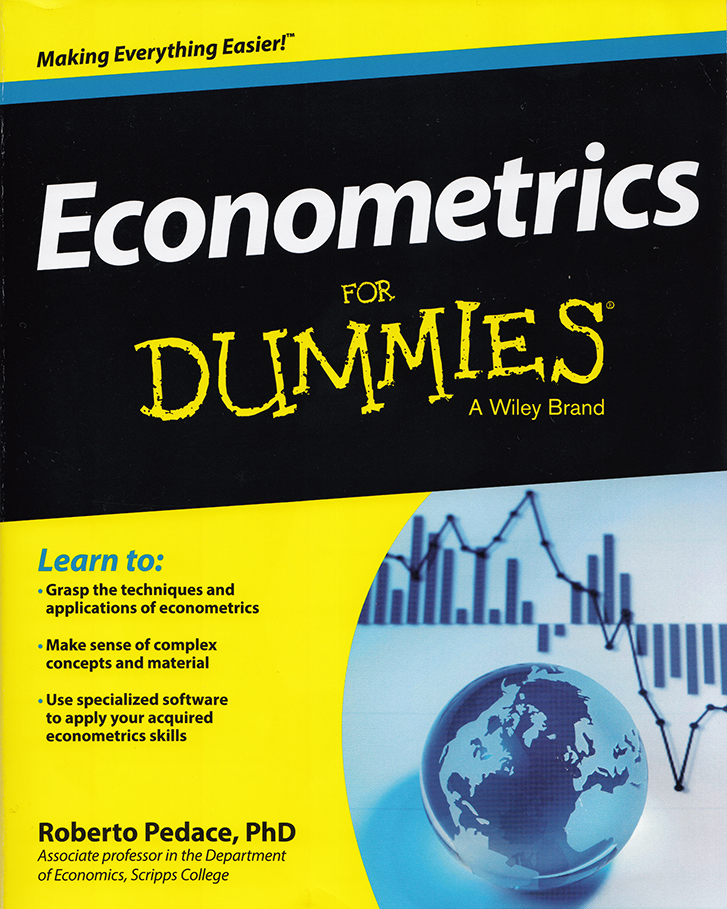

2025 Stata Economics Virtual Symposium • 6 November
Econometrics For Dummies |
||||||||||||||||||||||||||||||||||||
 Click to enlarge See the back cover |

As an Amazon Associate, StataCorp earns a small referral credit from
qualifying purchases made from affiliate links on our site.
eBook not available for this title
eBook not available for this title |
|
||||||||||||||||||||||||||||||||||
Comment from the Stata technical groupEconometrics for Dummies is an ideal companion for an introductory course in econometrics. The book is written for people that want to learn how to use econometrics in their research and complements the discussion of theory with advice about how to move from data and economic theory to estimation. All the computational examples and output in the book use Stata. The book assumes some previous knowledge of statistics and economics but does offer a comprehensive review of the basic concepts needed to understand the concepts in the text. The first part of the book is a review of basic statistics and probability, an introduction to Stata, and a discussion of the different types of data commonly encountered by researchers. The book then delves into the ordinary least-squares and the Gauss-Markov theorems. After presenting the Gauss-Markov theorem the author discusses the most common violations of the assumptions of the theorem — heteroskedasticity, collinearity, and autocorrelation — and how to diagnose and deal with them. The book also discusses binary outcome models, models for censored and truncated outcomes, sample selection, time-series models, and panel-data models. Econometrics for Dummies presents theoretical econometric results and provides an intuitive interpretation of them. The book is a good reference for those wanting to get an insight into basic econometric concepts encountered in an introductory econometrics course. |
||||||||||||||||||||||||||||||||||||
Table of contentsView table of contents >> Introduction
Part I: Getting Started with Econometrics
Chapter 1: Econometrics: The Economist's Approach to Statistical
Analysis
Chapter 2: Getting the Hang of Probability Chapter 3: Making Inferences and Testing Hypotheses Part II: Building the Classical Linear Regression Model
Chapter 4: Understanding the Objectives of Regression Analysis
Chapter 5: Going Beyond Ordinary with the Ordinary Least Squares Technique Chapter 6: Assumptions of OLS Estimation and the Gauss-Markov Theorem Chapter 7: The Normality Assumption and Inference with OLS Part III: Working with the Classical Regression Model
Chapter 8: Functional Form, Specification, and Structural Stability
Chapter 9: Regression with Dummy Explanatory Variables Part IV: Violations of Classical Regression Model Assumptions
Chapter 10: Multicollinearity
Chapter 11: Heteroskedasticity Chapter 12: Autocorrelation Part V: Discrete and Restricted Dependent Variables in
Econometrics
Chapter 13: Qualitative Dependent Variables
Chapter 14: Limited Dependent Variable Models Part VI: Extending the Basic Econometric Model
Chapter 15: Static and Dynamic Models
Chapter 16: Diving into Pooled Cross-Section Analysis Chapter 17: Panel Econometrics Part VII: The Part of Tens
Chapter 18: Ten Components of a Good Econometrics Research Project
Chapter 19: Ten Common Mistakes in Applied Econometrics Appendix: Statistical Tables
Index
|
||||||||||||||||||||||||||||||||||||
Learn
Free webinars
NetCourses
Classroom and web training
Organizational training
Video tutorials
Third-party courses
Web resources
Teaching with Stata
© Copyright 1996–2025 StataCorp LLC. All rights reserved.
×
We use cookies to ensure that we give you the best experience on our website—to enhance site navigation, to analyze usage, and to assist in our marketing efforts. By continuing to use our site, you consent to the storing of cookies on your device and agree to delivery of content, including web fonts and JavaScript, from third party web services.
Cookie Settings
Last updated: 16 November 2022
StataCorp LLC (StataCorp) strives to provide our users with exceptional products and services. To do so, we must collect personal information from you. This information is necessary to conduct business with our existing and potential customers. We collect and use this information only where we may legally do so. This policy explains what personal information we collect, how we use it, and what rights you have to that information.
These cookies are essential for our website to function and do not store any personally identifiable information. These cookies cannot be disabled.
This website uses cookies to provide you with a better user experience. A cookie is a small piece of data our website stores on a site visitor's hard drive and accesses each time you visit so we can improve your access to our site, better understand how you use our site, and serve you content that may be of interest to you. For instance, we store a cookie when you log in to our shopping cart so that we can maintain your shopping cart should you not complete checkout. These cookies do not directly store your personal information, but they do support the ability to uniquely identify your internet browser and device.
Please note: Clearing your browser cookies at any time will undo preferences saved here. The option selected here will apply only to the device you are currently using.